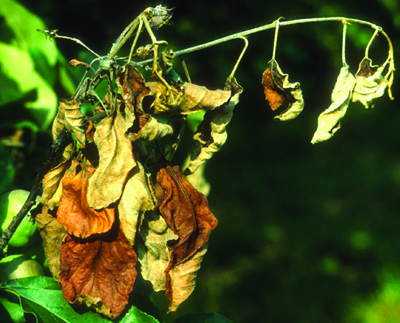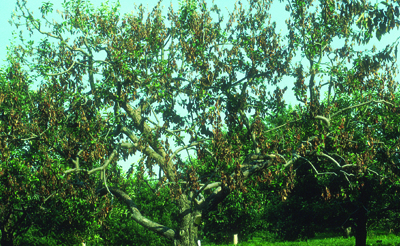Fire blight
July 30, 2015
Cause
Erwinia amylovora (bacterium)
Hosts
Apple, crabapple, hawthorn, pear, cotoneaster, mountain ash, spirea, and flowering quince.
Symptoms
Major symptoms of fire blight appear during warm, moist weather in late spring; however, larger cankered limbs may not die back until dry weather during mid-summer. Milky-white to amber droplets of bacterial ooze may exude from infected plant parts. Cambial tissue is killed in the region of the canker and will be brown or black instead of green. Bark in cankered areas is darker than surrounding tissue and may appear sunken.

Branches appear as if scorched by fire; branch tips curve downward in a characteristic shepherd’s crook.
How it’s spread
The bacteria overwinter in live tissue around the margins of fire blight cankers. Once temperatures are above 65°F, bacteria resume growth, and the disease can spread rapidly. Insects pollinating blossoms, rain splash, or infested pruning tools can all serve as means of spreading the bacteria.

Serious fire blight infections requiring major amounts of pruning are best undertaken during the dormant season so that bacteria aren’t spread. Make pruning cuts 10 to 12 inches below infected areas.
Management
Choose resistant cultivars or non-susceptible plants as replacements. For managing fire blight in existing plantings where replacement is not an option, limit applications of nitrogen fertilizer and heavy amounts of pruning, which encourage the development of succulent growth. Never prune when branches or foliage are wet. If minor amounts of infection are present, these branches can be pruned out during the growing season. Disinfest pruning tools between cuts with 10 percent household bleach. Disinfesting tools is not required during the dormant season. Douglas Chapman, director of Dow Gardens, has provided a list of fire blight-resistant crabapples based on observations over many years at Dow Gardens in Midland, Michigan. His list includes the following crabapples: ‘Adams,’ ‘Beverly,’ ‘Bob White,’ ‘Camelot,’ ‘Candied Apple,’ ‘Centurion,’ ‘Donald Wyman,’ Malus floribunda, ‘Golden Raindrops,’ ‘Harvest Gold,’ ‘Henningii,’ ‘Indian Magic,’ ‘Indian Summer,’ ‘Jewelberry,’ ‘Mary Potter,’ ‘Molten Lava,’ ‘Ormiston Roy,’ ‘Prairifire,’ ‘Professor Sprenger,’ ‘Silver Moon,’ ‘Strawberry Parfait,’ ‘Sugar Tyme,’ ‘White Angel,’ ‘Winter Gold,’ M. zumi var. calocarpa, ‘Red Jewel,’ ‘Ruby Luster,’ and ‘Sentinel.’ The University of Pennsylvania lists the following species and cultivars of pyracantha, cotoneaster and hawthorn as resistant to fire blight: Pyracantha ‘Mojave’, ‘Navaho’, ‘Teton’, and ‘Shawnee’ Cotoneaster Cotoneaster amoenus, C. adpressus, C. dammeri var. radicans, C. microphyllus, C. praecox, and C. zabelii Hawthorn (Crataegus) C. arnoldiana, C. coccinea, C. crus-galli, C. douglasii, C. phaenopyrum, C.prunifolia, C. punctata ‘Ohio Pioneer’, C. viridis ‘Winter King.’ Resistance to fire blight may not hold up over time or across locations. Strains of Erwinia amylovora, the bacterium responsible for causing fire blight, vary in virulence. Remember that resistant does not mean immune. Even when using resistant cultivars, it a good idea to avoid overcrowding plantings or planting in locations where air circulation is poor. Both of these conditions increase humidity and create more favorable conditions for development of fire blight.
Print a PDF of this page: Fire blight



 Print
Print Email
Email



